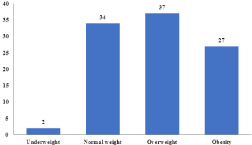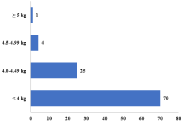Abstract
Background: Cases of Obese and overweight women at their childbearing age have exponentially increased over the last 30 years. These fluctuations in the body do increase the risks for the fetus and the mother during the pregnancy.
Aim: The purpose of this study is to determine the relationship between macrosomia and the preconception Body Mass Index (BMI) in a primary medical center in Tijuana, Mexico.
Design and Setting: Analytic cross-sectional study.
Methods: Patients with children born during 2019 that had recorded their weight and height on their medical records in addition to the weight of the new born were identified. In descriptive statistics we use frequencies and percentages for qualitative variables; for quantitative mean and standard deviation. The Chi-square test was used to establish the relationship between macrosomia and preconception BMI; logistic regression was used for multivariate analysis, a p <0.05 was considered statistically significant.
Results: there is association between macrosomia and preconception BMI. The most significant relationship was in the overweight and obesity categories (p= 0.006). Through logistic regression, it was possible to verify that the obesity category was the most important risk factor to explain newborn macrosomia (B 1.439, OR 4.2, 95% CI 1.5-11.2, p 0.004).
Conclusion: Obesity has a strong association with macrosomia; pre-pregnancy weight plays a key role determining birth weight.
Keywords: Macrosomia; Obesity; Pregnancy
Introduction
The nutritional status before and during pregnancy is a fundamental determinant for fetal growth and newborn weight [1] because the health before pregnancy is closely related to the outcome of this state. The BMI is a parameter that is used for the diagnosis of overweight and obesity with validity throughout the world, it is defined as the weight in kilograms divided by the height in meters squared (kg/m2); is classified according to the World Health Organization (WHO) as normal weight (18.5-24.9 kg/m2), overweight (25-29.9 kg/m2), obesity grade I (30-34.9 kg/m2), obesity grade II (35-39.9 kg/m2) and obesity grade III (≥40 kg/m2) [2].
Macrosomia refers to excessive intrauterine growth beyond a specific threshold regardless of gestational age. This condition is defined as a birth weight ≥ 4000 grams. The American College of Obstetricians and Gynecologists (ACOG) supports the use of 4500 gram threshold for the diagnosis of macrosomia because morbidity increases significantly beyond this weight. A variety of factors predispose the newborn to macrosomia, including pre-existing maternal diabetes, uncontrolled gestational diabetes, maternal obesity and excessive weight gain during gestation. The interaction of these risk factors is complex and varies according to the BMI before pregnancy, race and ethnicity [3].
Ai-Koyanagi et al (2013), analyzed data from 276,436 births in 363 institutions in 23 developing countries in Asia, Africa and Latin America, found that mothers with BMI ≥35 kg/m2 have a higher risk of macrosomia than those with BMI <30 kg/m2. The prevalence of macrosomia in developed countries has increased from 15% to 25% in the last three decades, mainly by the increase in obesity and maternal diabetes [4]. Overweight and obesity are a major problem among women of reproductive age in Latin America and the Caribbean, where it is estimated that 70% of women between 20-49 years of age are overweight or obese. The overall prevalence of large for gestational age newborns in Latin America and the Caribbean is 16.5%. The highest rate of this condition was reported in Mexico (21.9%) [5]. In Mexico, according to the National Health Survey (ENSANUT 2016), 70% (66.7% men and 71.9% women) of the Mexican adult population are overweight or obese [6]. The objective of the research was to determine the relationship between fetal macrosomia and the maternal preconceptional BMI in the family medicine unit #27 (FMU 27) in Tijuana, Mexico.
Material and Methods
Study Design and Population
An analytical cross-sectional study was carried out in Tijuana, Baja California, Mexico, between January and December 2019. The research was developed at FMU 27 of the Instituto Mexicano del Seguro Social (IMSS). Patients with live newborns during the mentioned time period and who also had a record of weight and height before pregnancy, as well as a record of the weight at birth of the newborn, were included. The sample size was determined according to the most recent prevalence of macrosomia according to the National Center for Health Statistics [7]. Based on the local consultation network, patients with a diagnosis of Normal Pregnancy were identified according to the International Classification of Diseases (ICD-10). Subsequently, the medical records of the mothers and their children were investigated in the Family Medicine Information System (SIMF).
Variables
The collection of variables was done with a standardized data form; the variables collected were the following: maternal age, maternal risk age (pregnancy before 20 years or after 35 years), education, occupation, preconception BMI, and gestational diabetes Mellitus. The weight of the newborns was classified as macrosomia (≥4,000 g), normal weight (≥2500-3999 g), underweight (≥1500 <2500 g) and the degree of macrosomia was classified according to the ACOG, which includes the following categories: grade 1 (4000-4499 g), grade 2 (4500-4999 g) and grade 3 (≥5000 g).
Statistical Analysis
For the measurement of quantitative variables, mean and standard deviation were used, frequencies and percentages for qualitative variables. To establish a relationship between macrosomia and preconception BMI, the Chi Square test was performed. A logistic regression model was applied, macrosomia as the dependent variable and the maternal variables as independent. Statistically significant differences were considered with p values <0.05. Statistical analysis was processed with IBM SPSS version 21 software.
Ethics
The study was approved by the Local Committee for Ethics and Health Research #204; with registration number R-2020-204-005. The research was carried out under the guidelines of the General Health Law on Health Research, the Declaration of Helsinki and Bioethical principles.
Results
The total population was 164 patients; the minimum age was 18 years and the maximum 43, with a mean of 26.49. 82.9% (n= 136) had a non-risk age between 20 to 35 years, only 17.1% (n= 28) had ages of higher maternal risk. In schooling, the majority had secondary and high school studies with 39% and 39.6% respectively (Table 1). In occupation 75.6% (n= 124) were workers. In the preconception BMI (Figure 1), the underweight category had 2.4% (n= 4), normal weight 33.5% (n= 55), overweight 36.6% (n= 60) and obesity 27.4% (n= 45). The newborn's weight obtained the following frequencies: low weight 2.4% (n= 4), normal weight 67.7% (n= 111) and macrosomia 29.9% (n= 49). The most frequent degree of macrosomia (Figure 2) was grade 1 with 25% (n= 41), 4.3% (n= 7) grade 2 and 0.6% (n= 1) grade 3; 70.1% (n = 115) of the newborns did not have macrosomia.
Variables
n
%
Age
< 20 years
11
7
20-35 years
136
83
> 35 years
17
10
Maternal risk age
Yes
28
17
No
136
83
Schooling
University
16
10
High school
65
40
Secondary
64
39
Primary
19
11
Occupation
Housewife
38
23
Student
2
1
Employee
124
76
n=frequency, %=percentage
Table 1: Basal characteristics of patients.

Figure 1: Pre-pregnancy BMI.

Figure 2: Degree of newborn macrosomia.
Table 2: Association between macrosomia and maternal BMI.
Multivariate Analysis
Final Model
β
Wald
OR (95% CI)
p value
Normal weight
-1.194
32.31
0.3 (0.1-0.7)
0.007
Overweight
1.254
11.13
3.5 (1.3-8.8)
0.008
Obesity
1.439
6.14
4.2 (1.5-11.2)
0.004
GDM
0.984
13.12
2.6 (1.1-6.1)
0.019
β= beta coefficient, OR= odds ration obtained through logistic regression, %= percentage, 95% CI= 95% Confidence Interval, GDM= Gestational Diabetes Mellitus.
Table 3: Logistic regression analysis.
In the bivariate analysis, an association was found between macrosomia and maternal preconception BMI (Table 2), with a greater association in the overweight (44.9%) and obesity (38.8%) categories with statistical significance (p= 0.006). It was detected that 34.7% of macrosomia cases were associated with gestational diabetes mellitus (GDM), with statistical significance (p= 0.002). No association was found between macrosomia with the maternal variables age and occupation. In the logistic regression analysis (table 3), we found maternal obesity as the main risk factor (B 1.439, OR 4.2, 95% CI 1.5–11.2, p 0.004). As a protective factor, we found the normal preconception weight (B -1.1, OR 0.3, 95% CI 0.1-0.7, p 0.007). These results confirm that weight gain before pregnancy has a linear relationship with birth weight; as a result, preconception maternal obesity is the most important risk factor for fetal macrosomia.
Discussion
Overweight and obesity are an important problem among women at their childbearing age. In our study it was found that more than half of the sample was overweight; specifically, 36.6% were overweight and 27.4% were obese, a total of 64%. This result is similar to that reported by the International Federation of Gynecology and Obstetrics in 2017 [5], where they report that 70% of women between 20 and 49 years old are overweight or obese. The most common macrosomia grade in our study was grade 1, representing 25% of the total sample (n= 41), grade 2 corresponds to 4.3% (n= 7) and grade 3 only 0.6% (n= 1), a similar finding to Salihu et al (2019) [8], who examined trends in fetal macrosomia and macrosomia phenotypes in the USA during the last five decades.
Agudelo et al (2019) [9] in a case-control study on factors associated with fetal macrosomia showed that pregnant women who presented excessive BMI before pregnancy, 64.8% had macrosomic newborns and in pregnant women with an adequate BMI, percentage decreases to 38.2%. Macrosomia was 1.6 times more likely in pregnant women with excessive BMI before pregnancy compared to normal weight (p= 0.004). In our study, this positive association is confirmed with the bivariate analysis, since of the total of newborns with macrosomia, 83.7% were in women with preconception excess weight (overweight 44.9% and obesity 38.8%) and only 16.3% had normal BMI, with statistical significance (p= 0.006) and verifiable through logistic regression. In our study we found that of the total of newborns with ≥4000 g, 34.7% were associated with GDM, this result is similar to the study by Garcia et al (2016) [10], where the group with macrosomia presented alterations in glucose in 30.4% versus 69.6% without alterations.
Conclusion
In conclusion, the main purpose of our study was to investigate the role of maternal preconception BMI in the weight of the newborn, which was satisfactorily met, since based on our results we found that overweight and obesity have a strong association with macrosomia. As health professionals, it is important in our daily medical consultation to identify women of reproductive age who are planning a pregnancy, especially those who are overweight and obese, to offer an opportunity to improve obstetric and neonatal outcomes.
References
- Stephenson J, Heslehurst N, Hall J. Before the beginning: nutrition and lifestyle in the preconception period and its importance for future health. Lancet. 2018; 391: 1830-1841.
- Lozano-Bustillo A, Betancourth-Melendez WR, Turcios-Urbina LJ. Sobrepeso y Obesidad en el Embarazo: Complicaciones y Manejo. Arch Med. 2016; 12: 1-7.
- American College of Obstetricians and Gynecologists. Fetal Macrosomia. Obstet Gynecol. 2016; 128: 195-220.
- Koyanagi A, Zhang J, Dagvadorj A. Macrosomia in 23 developing countries: an analysis of a multicountry, facility-based, cross-sectional survey. Lancet. 2013; 381: 476-490.
- Federacion Internacional de Ginecologia y Obstetricia. Declaracion del Area de Latinoamerica y Caribe Sobre la Hiperglucemia en el Embarazo. Mexico. 2017.
- Instituto Nacional de Salud Publica. Encuesta Nacional de Salud y Nutricion de Medio Camino 2016 Informe Final de Resultados. Mexico. 2016.
- Hamilton BE, Martin JA, Osterman MJ. Births: Final Data for 2014. Natl Vital Stat Rep. 2015; 64: 1-64. King LM. Trends in the incidence of fetal macrosomia and its phenotypes in the United States, 1971-2017. Arch Gynecol Obstet. 2019; 301: 415-426.
- Agudelo-Espitia V, Parra-Sosa BE, Restrepo-Mesa SL. Factores asociados a la macrosomia fetal. Rev Saude Publica. 2019; 53: 1-10.
- Garcia-De la Torre JI, Rodriguez-Valdez A, Delgado-Rosas A. Factores de riesgo de macrosomia fetal en pacientes sin diabetes mellitus gestacional. Ginecol Obstet Mex. 2016; 84: 164-171.
